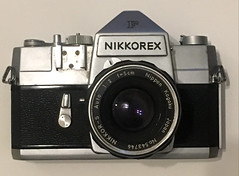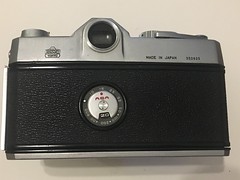Nikkorex F

|
| image by Film Shooter (Image rights) |
Nikkorex F, made by Mamiya for Nikon, also sold as Nikkor J. Introduced in 1962, it was the first production single-lens reflex camera with the vertically travelling metal Copal Square shutter. The Ricoh Singlex also sold as Sears SL 11 is very similar. The camera is branded as one of the budget Nikkorexes, but is vastly superior to the true Nikkorexes in every way, with solid metal construction, interchangeable lenses, and an early version of what was to be a highly revolutionary shutter. In essence, the camera is an intermediate between the Nikkorexes and the Nikons. It lacks the deluxe features of the F-series such as interchangeable finders, while having the same mount and arguably a better shutter. In some ways, it is a predecessor to the Nikomat/Nikkormat budget models that would come later.
Contents
Physical description
The camera is physically very substantial, being heavier and larger than, say, the Pentax Spotmatic from a few years later; this is a common thread among Mamiya's SLR's. The lens assembly is off-center on the front of the camera, with a large pentaprism housing (thus immediately differentiating this camera from the other Nikkorexes, with their porroprism finders) marked with a large "Nikkorex" badge immediately above the lens, and a black-bordered "F" above that.
The controls are generally conventional. On top of the camera, there are a large speed selector dial with a stud for the accessory meter, the shutter release, film advance, exposure counter and rewind knob. The film-plane is indicated with the conventional mark on the top plate.
On the right side of the lens mount housing, a small control sticks out. Sliding this down stops down the aperture and previews depth-of-field. Next to this on the camera front is the self-timer lever, and above the self-timer, an oddly-placed cold shoe to attach the very large accessory meter as shown in the main image. Some very small electronic flashes with pivoting heads and PC sync could theoretically be mounted to this, but it is not its intended purpose.
The back has its own latch; pulling the rewind knob out does not release it. Above the latch are two PC ports for M and X sync. On the back, there is a film-type reminder, which has one dial for the film speed (10-800 ASA) and an inner dial with the numbers "20" and "36" marked twice, once with a red and then with a black background. The number refers to the two commonly available lengths of a 35mm roll at the time (24-exposure rolls existed even then, however). The background on the inner dial is probably to remind the photographer what kind of film is in the camera; for instance, red could indicate color and black could indicate b/w.
The viewfinder has a very large circular eyepiece for adding accessories such as an eye-cup or a prescription diopter to compensate for bad eyesight.
Lens mount
The camera has a standard F-series bayonet mount. On its own the camera possesses no means of operating the aperture "shoe" standard on the contemporary F-lenses (the small slotted piece of metal that sticks out of the aperture ring. However, the accessory meter can operate both it and the shutter-speed dial. The camera does, however, automatically stop down and reopen the aperture when releasing the shutter.
Shutter
At a time when the focal-plane shutter had existed in roughly the same form for many decades, the Copal Square was a welcome change, with metal blinds rather than delicate and degradable cloth shutters. Mechanical Copal Square shutters tend to remain functional longer than cloth shutters, and give X-sync at higher speed (1/125th, in this case.) Shutter speeds above 1/125th are in green on the dial, while 1/125th-1 second are marked in orange and B is marked in white.
|
Conclusion
While this camera was a budget model at the time, it is a little hard to find now, and can be expensive if sold online. However, cheap examples from garage sales and the like may be well worth buying, especially given the large number of excellent lenses that it can take. As the shutter is very often still in working condition, it is possible to have a fully mechanical f-mount SLR in perfect condition without the expense of a Nikon from the same era. It has no battery to leak acid into the baseplate, no tediously delicate mechanical linkages associated with in-viewfinder displays, no threading in the lens mount to wear out over time; in short, there is very little other than the shutter that can realistically fail under normal circumstances on the Nikkorex F.
Technical specifications
- Type: 35mm SLR
- Manufacturer: Mamiya for Nippon Kougaku
- Lens mount: Nikon F mount
- Shutter: Copal Square vertical travel metal-blind mechanical focal-plane shutter
- Shutter speeds: 1/1000th-1 second, B
- Flash sync: F, X at 1/125th.
- Exposure: Manual, designed to use clip-on accessory meter.
- Viewfinder: SLR with fresnel focusing screen and split-screen device
Links
- Nikkorex F at Nikon's History & Technology site
- The Nikkorex F at Cameraquest
- The black Nikkorex F at Cameraquest
- The Nikkorex F with meter at Rick Housh's site
- Nikkorex F and clones at Rick Housh's site
- Mamiya Prismat and Nikkorex F at Herron's site
- The first Nikon SLR's at Photography in Malaysia
- The Nikkorex F at Peter Lausch's site
- Nikkorex F at Ari's site
- The Nikkorex F at Takojin's site
- The Nikkorex F at nikomat.org
- Nikkorex F Instruction manual - English at Butkus.org
| Nikon 35mm SLR Cameras | |
|---|---|
| Nikkorex F | Nikon EL2 | Nikon EM | Nikon F | Nikon F2 | Nikon F3 | Nikon F4 | Nikon F5 | Nikon F6 | Nikon F50 | Nikon F55 | Nikon F60 | Nikon F65 | Nikon F70 | Nikon F75 | Nikon F80 | Nikon F90 | Nikon F90X | Nikon F100 | Nikon F-301 | Nikon F-401 | Nikon F-401S | Nikon F-401X | Nikon F-501 | Nikon F-601 | Nikon F-601M | Nikon F-801 | Nikon F-801s | Nikon FA | Nikon FE | Nikon FE2 | Nikon FE10 | Nikon FG | Nikon FG-20 | Nikon FM | Nikon FM2 | Nikon FM2n | Nikon FM3A | Nikon FM10 | |
| Nikomat / Nikkormat | |
| EL | EL2 | ELW | FS | FT | FT2 | FT3 | FTN | |

